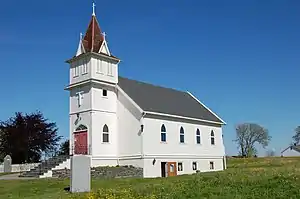Western Norway Emigration Center
Western Norway Emigration Center (Norwegian: Vestnorsk utvandrarsenter or Vestnorsk utvandringssenter) is an open-air museum located at the village of Sletta on the island of Radøy in Vestland county, Norway. The museum consists of a small church and several historical buildings which were reassembled in a rural environment. The building were re-located from Minnesota and North Dakota from locations characterized by Norwegian American immigration during the end of the 19th and the beginning of the 20th century.

%252C_Emigrantkyrkja_(Brampton_Lutheran_Church%252C_North_Dakota)_%2526_Vestnorsk_utvandringssenter_(Western_Norway_Emigration_Center)%252C_Rad%C3%B8y%252C_Hordaland%252C_Norway_2017-10-03_c.jpg.webp)
Rad%C3%B8y%252C_Hordaland%252C_Norway_2017-10-03_cropped_distorted_panorama_a.jpg.webp)
Museum Centre in Hordaland
Western Norway Emigration Center is operated in cooperation with the Museum Centre in Hordaland (Museumssenteret i Hordaland) which focusing on the preservation of the social and cultural history of Hordaland. King Harald and Queen Sonja have honored the museum with a visit. Western Norway Emigration Center is the site of several activities throughout the year including weddings, meetings, concerts, and festivals. There are guided tours around the center. There is also a library with books about Norwegian emigration to North America.[1]
Brampton Lutheran Church
In 1996, Brampton Lutheran Church was dismantled and moved from Brampton Township, Sargent County, North Dakota. The entire church, with all inventory, was given as a gift to the Western Norwegian Emigration Center. Volunteers, both Norwegian and American, dismantled the church for transport to Sletta, where it was re-assembled. Brampton Lutheran Church was subsequently consecrated by Ole Hagesæther, Bishop of the Diocese of Bjørgvin (1994–2008) and officially reopened as Emigrantkirka på Sletta.[2][3]
Marboe Township School
Dating from 1893, this is a typical one room school from Sargent County, North Dakota. It was moved to Forman, North Dakota, near Brampton, in the 1960s where it was used as a museum. In 1997, Sargent County Farm Bureau donated the school to the Western Norwegian Emigration Center. It opened on July 8, 2000.[4]
Dr. J.C. Serkland Medical Office
This building was taken from Rothsay in Wilkin County, Minnesota. It was the office of Doctor John Christian Serkland (1872- 1948) during more than 50 years of medical practice. His grandchildren purchased the house and donated it to the Western Norwegian Emigration Center. It was officially opened on July 8, 2000.[5] [6]
Underwood Pioneer House
The Underwood Pioneer House was the home of Andreas Seem (1820-1890), an immigrant from Nord-Trøndelag, Norway. The house was originally built following his arrival during 1869 in Underwood in Otter Tail County, Minnesota. Luverne Kiene, the great grandchild of Karen and Andreas Seem, donated the house to the Western Norwegian Emigration Center in 1997. It was officially opened on July 8, 2000.[7][8]
Brampton School Teacher's Home
This was apparently the oldest house in Brampton township. The year of construction is unknown, but the fireplace construction indicates that it is probably as old as the European settling of North Dakota. It housed the principal of the school until the 1930s. Sanford and Genevieve Cooper donated the house to the Western Norway Emigration Center in 1997. The house was officially opened on July 8, 2000.[9]
Elizabeth Township Jail and Town Hall
Elizabeth Township Jail and Town Hall were built in the 1880s and incorporated to one building. The jail with two cells was used until slightly after 1900. The Town Council of Elizabeth, Minnesota, donated the building to the Western Norwegian Emigration Center during the spring 2000. It was officially opened on July 6, 2002.[10]
Asbjørn Ystebø
Asbjørn Odd Ystebø was a teacher at Danielsen Videregående Skole, an independent Christian high school in Bergen, Norway who had an important role in the exchange agreement between his high school and Hillcrest Lutheran Academy in Fergus Falls, Minnesota. During a visit in the United States in 1992-93, Ystebø got the idea of establishing a Norwegian American center in his home village of Sletta. Rural townships in Minnesota and North Dakota had in many cases experienced dramatic population decreases. As a result, there were historic building available for relocation. Asbjørn Odd Ystebø would later receive the St. Olav's Medal based upon his engagement in Norwegian and American relations. [11][12] [13]
Gallery of Memorial Stones
_Norr%C3%B8nafolket_det_vil_fare_(The_Norsemen_sailed_and_settled)_ved_Emigrantkyrkja_(Brampton_Lutheran_Church%252C_North_Dakota)_%2526_Vestnorsk_utvandringssenter_i_Rad%C3%B8y%252C_Hordaland%252C_Norway_2017-10-03_a.jpg.webp) Memorial stone honoring Norsemen who sailed and settled
Memorial stone honoring Norsemen who sailed and settled_over_F%C3%B8regangsmenn_for_skisporten_(Norwegian-American_skiing_pioneers_in_the_USA_%2526_Canada)_ved_Emigrantkyrkja_church_og_Vestnorsk_utvandringssenter_i_Rad%C3%B8y%252C_Hordaland%252C_Norway_2017-10-03.jpg.webp) Memorial stone honoring Norwegian-American skiing pioneers
Memorial stone honoring Norwegian-American skiing pioneers_over_Marcus_Thrane_ved_Emigrantkyrkja_(Brampton_Lutheran_Church%252C_North_Dakota)_%2526_Vestnorsk_utvandringssenter_(Western_Norway_Emigration_Center)%252C_Rad%C3%B8y%252C_Hordaland%252C_Norway_2017-10-03.jpg.webp) Memorial stone honoring Marcus Thrane
Memorial stone honoring Marcus Thrane_over_Norwegian-American_Pioneer_Women_Agnes_Mathilde_Wergeland_%2526_Elise_Amalie_Tvede_W%C3%A6renskjold%252C_Emigrantkyrkja_Church_%2526_Vestnorsk_utvandringssenter%252C_Rad%C3%B8y%252C_Hordaland%252C_Norway_2017-10-03.jpg.webp) Memorial stone honoring Agnes Mathilde Wergeland & Elise Wærenskjold
Memorial stone honoring Agnes Mathilde Wergeland & Elise Wærenskjold_2._verdenskrig_(WW2)_US_Army_Ski_Troopers_(99th_Infantry_Battalion)%252C_Office_of_Strategic_Services)_ved_Emigrantkyrkja_Church_%2526_Vestnorsk_utvandringssenter%252CRad%C3%B8y%252C_Hordaland%252C_Norway_2017-10-03.jpg.webp) Memorial stone honoring U.S. Army Ski Troopers of the 99th Infantry Battalion
Memorial stone honoring U.S. Army Ski Troopers of the 99th Infantry Battalion
References
- Museum Centre of Hordaland (European Heritage Association)
- The Emigrant Church, Emigrantkyrkja (Radøy Kommune)
- Årsmøte i Radøy sokn (Den Norske Kirke)
- Sargent County Farm Bureau (North Dakota)
- "John Christian Serkland". Roorsweb Person Sheet. 22 Mar 2011. Retrieved October 31, 2015.
- J.C. Serkland’s Medical Office (Pinterest)
- Underwood Pioneer House (Pinterest)
- "Underwood" (PDF). Tour Otter Tail Co MN. Retrieved October 31, 2015.
- Brampton School Teacher’s Home (Pinterest)
- Elizabeth's Jail and Town Hall (Pinterest)
- Asbjørn Ystebø, Radøy (St. Olavsmedaljen)
- Bergensavisen Asbjørn Ystebø får St. Olav (NRK Nyheter)
- Skolens historie (Danielsen Videregående Skole)
| Wikimedia Commons has media related to Western Norway Emigration Center. |